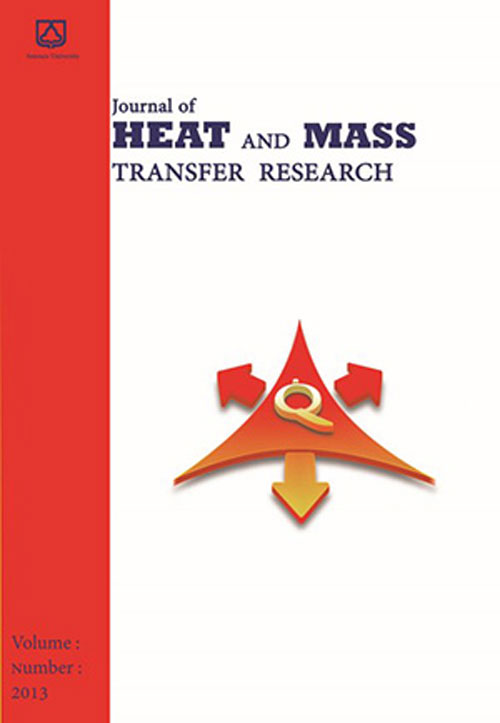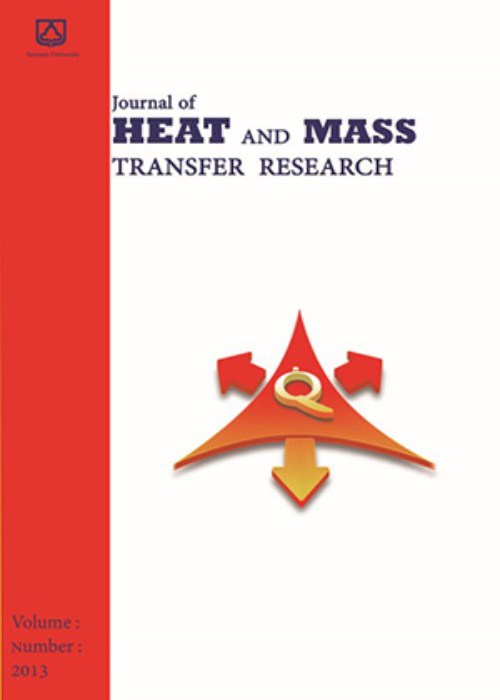فهرست مطالب

Journal of Heat and Mass Transfer Research
Volume:3 Issue: 1, Winter-Spring 2016
- تاریخ انتشار: 1395/08/30
- تعداد عناوین: 7
-
-
Pages 1-7The feasibility of extractive reaction of methacrylic acid from aqueous solution using a quaternary amine, trioctyl methyl ammonium chloride (TOMAC) as an extractant, was studied. The diluents chosen in the present work belong to different chemical classes, nbutyl acetate, carbon tetrachloride, isoamyl alcohol, methyl isobutyl ketone, and toluene. The effect of initial acid concentration in the aqueous phase, and initial extractant concentration in the organic phase were studied. The performances of physical and reactive extraction of individual diluents were reported in terms of overall distribution coefficient, overall loading ratios, and stoichiometric loading ratios. Maximum extractability was observed in case of methyl isobutyl ketone, while minimum with carbon tetrachloride. The remarkable feature of linear solvation energy relationship (LSER) modeling is that it takes into account physical interactions. To check the accuracy of the experimental observations, they were correlated with the LSER modeling parameters, and fairly good agreement was observed between them.Keywords: Methacrylic acid, extractant, diluent, distribution coefficient, Modeling
-
Pages 9-19The present study deals with the analysis of the effects of radiative heat transfer of micropolar fluid flow over a porous and stretching sheet in the presence of magnetic field. The dynamic viscosity and thermal conductivity coefficient have formulated by temperature-dependent relations to obtain more exact results. The flow is supposed two-dimensional, incompressible, steady and laminar and the applied magnetic field is assumed uniform. On the other hand, the velocity of the isothermal stretching sheet varies linearly with the distance from a fixed point on the sheet. The governing equations have extracted using the theory of micropolar fluid and the boundary layer approximation. Then they have been solved by similarity solution relationships, shooting method and fourth-order Runge-Kutta method. The results express that the presence and increase of variable thermal conductivity parameter, magnetism, radiation and variable viscosity parameter cause to decrease of heat transfer from the sheet, while increase of material parameter, Prandtl number and suction parameter increase the rate of heat transfer from the sheet. Also the values of dimensionless velocity are enhanced by increase of variable thermal conductivity parameter, material parameter and radiation parameter. On the other hand, the values of dimensionless angular velocity are completely influenced by the values of the velocity gradient.Keywords: Micropolar fluid, Radiation, Magnetic field, Viscosity, Thermal conductivity
-
Pages 21-30This paper addresses the combined effects of couple stresses, thermal radiation, viscous dissipation and slip condition on a free convective flow of a couple stress fluid induced by a vertical stretching sheet. The Cogley- Vincenti-Gilles equilibrium model is employed to include the effects of thermal radiation in the study. The governing boundary layer equations are transformed into a system of nonlinear differential equations, and solved numerically using the Runge-Kutta fourth order method with shooting technique. Numerical results are obtained for the fluid velocity, temperature as well as the shear stress and rate of heat transfer. The effects of the pertinent parameters on these quantities are examined. It is found that both the fluid velocity and temperature reduce in the presence of thermal radiation. Increasing values of the couple stress parameter thicken the momentum boundary layer. The slip parameter greatly influences the fluid flow and shear stress on the surface of the stretching sheet.Keywords: Slip flow, couple stress fluid, stretching sheet, thermal radiation, viscous dissipation
-
Pages 31-46Effects of some thermo-physical parameters on free convective heat and mass transfer over a vertical stretching surface at lowest level of heat energy in the presence of suction is investigated. The viscosity of the fluid is assumed to vary as a linear function of temperature and thermal conductivity is assumed constant. A similarity transformation is applied to reduce the governing equations into a coupled ordinary differential equations corresponding to the momentum, energy and concentration equations. These equations along with the boundary conditions were also solved numerically using shooting method along with Runge-Kutta Gill method. The effects of thermo-physical parameters on the velocity, temperature and concentration profiles are shown graphically. It is found that with an increase in the value of temperature-dependent fluid viscosity parameter, the velocity increases while the temperature and concentration decreases across the flow region. Dufour, Soret, Frank-Kamenetskii, Prandtl and Schmidt number activation energy also have effect. Numerical data for the local skin-friction coefficient, the local Nusselt number and the local Sherwood number have been tabulated for various values of certain parameter conditions.Keywords: free convection, Newtonian Fluid, Variable fluid viscosity, Surface at Absolute zero, Dufour, Soret
-
Pages 47-55Small scale thermal devices, such as micro heater, have led researchers to consider more accurate models of heat in thermal systems. Moreover, biological applications of heat transfer such as simulation of temperature field in laser surgery is another pathway which urges us to re-examine thermal systems with modern ones. Non-Fourier heat transfer overcomes some shortcomings of Fourier heat transfer, when small scale systems as considered or non-homogeneous materials are under study. In this paper, the hyperbolic heat conduction problem in a sphere is solved by three approaches.
1. Finding the exact solution by using the method of separation of variables
2. Finding two approximate solutions by using the Laplace transformation and then
a. applying the variational method for finding the Laplace inverse
b. finding the solution of the problem in Laplace domain and using an asymptotic series to evaluate the solution for small values of times
Various orders for the variational method are considered and compared against analytical solution. Since the two latter methods can be used in nonlinear problems such as those include radiation heat loss, the approximate solutions can be useful addition in the field of thermal analysis of non-Fourier problems.Keywords: Non, Fourier heat conduction, variational formulation, Laplace transformation, separation of variables, spherical coordinate -
Pages 57-66The shape of a solar collector is an important factor in solar-to-thermal energy conversion. Conical shape is one of the stationary and symmetric shapes that can be employed as a solar water heater. Flow rate of working fluid on the solar collector has an important effect on the efficiency of the collector. The present study is an experimentally investigated of the performance of the solar conical collector with 1m2 of absorber area at different volumetric flow rates. Water was used as the working fluid with the volumetric flow rate between 0.35-2.8 lit/min and the experiment was held in the ASHRAE standard conditions. The results demonstrated that the efficiency of the conical collector is increased by increasing the flow rate of the working fluid; in addition, the difference between inlet and outlet temperatures is decreased. The maximum recorded outlet-temperature of the collector during the experimental tests was 77.1 0 C and the maximum value of thermal efficiency was about 60%.Keywords: solar conical collector, symmetric collector, different flow rate, collector efficiency, experimental investigation
-
Pages 67-76Many studies are performed by researchers about Shell and Tube Heat Exchanger but the Multi-Objective Big Bang-Big Crunch algorithm (MOBBA) technique has never been used in such studies. This paper presents application of Thermal-Economic Multi-Objective Optimization of Shell and Tube Heat Exchanger Using MOBBA.
For optimal design of a shell and tube heat exchanger, it was first thermally modeled using e-NTU method while Bell-Delaware procedure was applied to estimate its shell side heat transfer coefficient and pressure drop. MOBBA method was applied to obtain the maximum effectiveness (heat recovery) and the minimum total cost as two objective functions. The results of optimal designs were a set of multiple optimum solutions, called Pareto optimal solutions'. In order to show the accuracy of the algorithm, a comparison is made with the non-dominated sorting genetic algorithm (NSGA-II) and MOBBA which are developed for the same problem.Keywords: Shell, Tube Heat Exchanger, Multi, Objective Big Bang, Big Crunch algorithm (MOBBA), Non, Dominated Sorting Genetic Algorithm (NSGA, II), Effectiveness, Total cost


